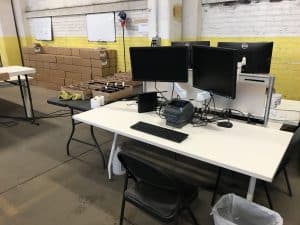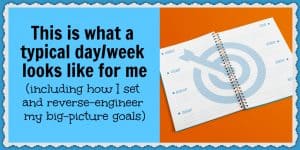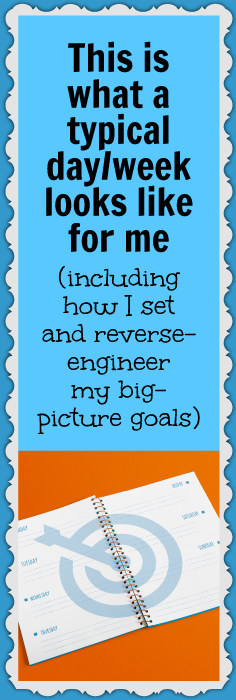So my days aren’t always all that “typical” since I do a lot of traveling and move around a fair amount. But when I’m more settled, I like to stick to somewhat of a routine, especially when it comes to goal-setting.
Routines are helpful for maintaining productivity and getting into a steady workflow. And goal-setting is useful because it involves establishing benchmarks so you can make sure you’re progressing according to plan. Plus, it gives you a solid target to shoot for.
When you don’t have much of a routine and haven’t set any definitive goals, you might find yourself shooting in the dark and not making much measurable progress towards anything.
Below, I walk you through my process of setting goals for twelve weeks out and how I break those goals down into smaller weekly and daily goals — or my goals’ actionable components.
I also share the recurring tasks and practices I always have on my weekly to-do lists along with some of my top tips and practices for creating an optimal “typical” workday.
Let’s dive in…
Here’s how I set goals for myself and structure my days/weeks…
I document pretty much all of my goals and to-do lists in Evernote, which is a fantastic note-taking app. And here’s how I structure all of that…
Vision statement
First, I’m going to walk you through the big picture.

Everything starts with my vision statement, which includes where I want to be in the future, tying together all of the most important areas of my life. Clarity is key here, because if you don’t know where you’re going, then how can you get there?
Example:
My vision is to earn enough money to support myself in the lifestyle I want and to be able to help my family and friends if they are ever in need. It’s also part of my vision to be doing something that I personally find rewarding; I want to have a positive impact on the world.
Even if I don’t actively look at my vision statement every day, having come up with that clarity in the first place, it’s always in my mind and it gets in my subconscious and helps me with my goals. My vision statement also helps align me with all of my other goals that I create.
12-week goals
Then, I have my top three goals for the next twelve weeks. I typically pick big goals that other people might set as yearly goals. But I do my best to knock them out even more quickly. And I think it’s totally possible to do this when you’re intentional about it.
There’s a great book that can help you learn more about how to do this. It’s called The 12 Week Year.
Examples that you might use:
Have $100k in my bank account
Start making 100 sales a day
Create 1-2 more lucrative, passive income streams
When it comes to bigger-picture goal-fulfillment, I’m essentially working backwards, or reverse-engineering, my twelve-week goals. So every week, usually on Sunday, I go through and chunk down my twelve-week goals into the various, smaller components necessary to make these goals happen.
Example:
Say I want to write and publish a new book in twelve weeks. Publishing a new book is the big-picture goal. And the smaller components necessary to achieve this goal might be something like this:
- Create an outline (the table of contents)
- Write a first draft of chapter 1
- Write a first draft of chapter 2
- Write a first draft of chapter 3 (and so on for all of the foreseen chapters)
- Write a second draft of the book
- Hire an editor on Fiverr to do a final look-over
- Hire a designer on Fiverr to create a book cover
- Split-test a couple different title options
- Get the book formatted for Kindle
- Publish the book on Amazon
- Send out a social media and email blast letting everyone know about my new book

Then, I’d need to create a schedule, which might go something like…
Week 1: Create an outline and write the introduction
Week 2: Write the first draft of chapter 1
Week 3: Write the first draft of chapter 2
Week 4: Write the first draft of chapter 3
Week 5: Write the conclusion and the second draft of the introduction
Week 6: Write the second draft of chapter 1
Week 7: Write the second draft of chapter 2
Week 8: Write the second draft of chapter 3 and the conclusion
Week 9: Split-test different title options and hire an editor and cover designer on Fiverr
Week 10: Ask for any necessary revisions
Week 11: Get the book formatted for Kindle
Week 12: Publish the book on Amazon and promote it via email and social media
To learn more about the process of reverse-engineering, you can check out my book Take Control Of Your Life.
Weekly goals
Next, I have my weekly goals as part of my weekly to-do list (these are all of the broken-down goals I come up with after reverse-engineering my big-picture goals).

I try to focus on the tasks aimed at achieving my twelve-week goals and not as much on busy work, which I think is really important to do.
Examples:
Write one new chapter for the book.
Identify and implement at least one lead system, or one new thing I can do to get new people onto my email list.
Daily goals
Then, I have my daily goals, which are my weekly goals broken down even further into the actionable steps I should be taking each day of my workweek.
Examples:
Write three pages for the first chapter.
Start researching lead systems, coming up with 10-20 viable options.
Create a new “not” to-do list, or one thing I’ve been doing that I want to stop doing, because the power lies really in removing things from my to-do list.
Recurring items
And here’s a list of things I do on a regular basis…

Every day, I come up with 1-3 things I want to accomplish that fall most in line with my bigger-picture goals and that, if I accomplish them, it’ll make me feel really good. For example…
Sending out an email to my list is something that always makes me feel good because it fulfills my goals of providing great content to people and feeling happy about building relationships with the people on my list.
Working on a sales letter is another task that usually feels really go to me and falls in line with my bigger-picture goals.
And when I’m not travelling, my daily morning routine consists of…
- meditation
- keeping a gratitude log
- stretching
- listening to motivational videos or books on Blinkist (there’s a quote that says something about how if what your listen to during the first 30 minutes that you’re awake kind of sets the tone or spirit of your day).
And here are some other things I consistently do each week…
Monday
Gratitude log
1pm EST meeting with Glenn
Tuesday
Gratitude log
Wednesday
Gratitude log
4pm EST meeting with Joel
Send out email to my list
Thursday
Gratitude log
Friday
Gratitude log
2pm EST management call
3pm EST chat with my mom
Check Trello and respond to any messages from my assistant
Send out a 515 report to my mentor
My 515 report is an awesome way of making sure I’m focusing on the most important things. It includes a summary of the work I’ve done along with three personal victories and lessons along with one idea to improve my business.
You’ll also notice that I make a point of practicing gratitude each and every day as a way of maintaining a positive and motivated mindset.
Plus, I have some weekly recurring meetings and I always make a point to check Trello on Friday at least.
Here are some of my best practices and tips for a typical workday…
Each day, I have two main-ticket tasks I want to complete and maybe a few other small things.

I always try to complete the hardest tasks first, when I’m fresh and energized and feeling the most disciplined. To help stay on track, I use a timer called race against the clock.
One problem I’ve noticed that a lot of entrepreneurs face is they have trouble calling it quits at the end of the day. When you’re working on your own business, it’s sometimes hard to pull the plug and say that’s enough for one day.
I personally feel happy after completing my top two main-ticket tasks for the day. And after those are done, I typically feel satisfied enough to stop working and either relax or do something fun.
I try to give myself 3-5 hours’ worth of really good work and then I’ll spend some time on smaller, maintenance type tasks. But I do also outsource some of these types of tasks as well.
Also — and this is important — anytime a task comes up that doesn’t relate to my two main goals for the day, I try my best to say no. There are so many opportunities out there, and saying no can often be tough. But you need to keep your goals in mind at all times and make sure that everything you’re working on falls in line with those goals. You need to be intentional about your progress.
I really hope you found this post useful! Please leave a comment below and share your thoughts. I’d also love to hear about how a typical day in your life goes!





